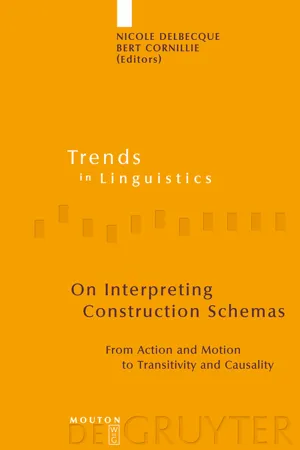
On Interpreting Construction Schemas
From Action and Motion to Transitivity and Causality
- 378 pages
- English
- PDF
- Available on iOS & Android
On Interpreting Construction Schemas
From Action and Motion to Transitivity and Causality
About this book
This volume addresses the constructional variability with transitive and causative verbs from the point of view of their respective action and motion patterns. Drawing on the theoretical advances registered in cognitive approaches to language (Cognitive Grammar, Construction Grammar and space semantics), the papers substantiate new interpretations and adduce empirical evidence from various languages to refine or adjust existing analyses of transitivity and causation.
The different contributions all address the crucial question of how concrete and abstract notions of human behavior drive linguistic expressions. Cognitive linguists consider that linguistic competence functions in terms of complex conceptual units: the native speaker knows and manipulates conceptual blocks without paying further attention to their constitutive parts or their internal organization. However, as this volume illustrates, the role of the constitutive parts and their internal organization cannot simply be reduced to zero. A multidimensional approach to construction schemas is at stake. That is, the speaker applies proper embodied subroutines to build a coherent meaning, but the construction schemas are also rooted in the linguistic patterns the speaker and hearer are familiar with.
The volume is primarily intended for scholars working within cognitive-semantic research at large. Given its theoretical and applied character (in the sense of giving empirical evidence for specific problems in the grammar), the volume will also be of great interest to anyone concerned with syntactic processes, construction grammar or with the cognitive structure of discourse. The descriptive and theoretical insights indeed dwell on areas that are currently dealt with in modern linguistics.
Frequently asked questions
- Essential is ideal for learners and professionals who enjoy exploring a wide range of subjects. Access the Essential Library with 800,000+ trusted titles and best-sellers across business, personal growth, and the humanities. Includes unlimited reading time and Standard Read Aloud voice.
- Complete: Perfect for advanced learners and researchers needing full, unrestricted access. Unlock 1.4M+ books across hundreds of subjects, including academic and specialized titles. The Complete Plan also includes advanced features like Premium Read Aloud and Research Assistant.
Please note we cannot support devices running on iOS 13 and Android 7 or earlier. Learn more about using the app.
Information
Table of contents
- Frontmatter
- Table of contents
- Introduction
- A usage-based approach to prototypical transitivity
- Transitivity and referentiality in Spanish and Rumanian
- Transitive verbs with non-accusative alternation in Hebrew: Cross-language comparison with English, German and Spanish
- Unsubcategorized objects in English resultative constructions
- Complex predicates in Basque
- An adversative passive in English: in search of origins
- Verbs of letting: Some cognitive and historical aspects
- Syntactic and semantic integration in the Spanish causative-reflexive construction
- Soft causatives in Spanish
- Two causal alternatives: carry vs. push type constructions in English
- Grammar of “manner of motion” verbs in English and Spanish: between lexicon and syntax
- On the nature of lexicalization patterns: a crosslinguistic inquiry
- The semantics of space : A study of the prefix proin Serbian
- Backmatter